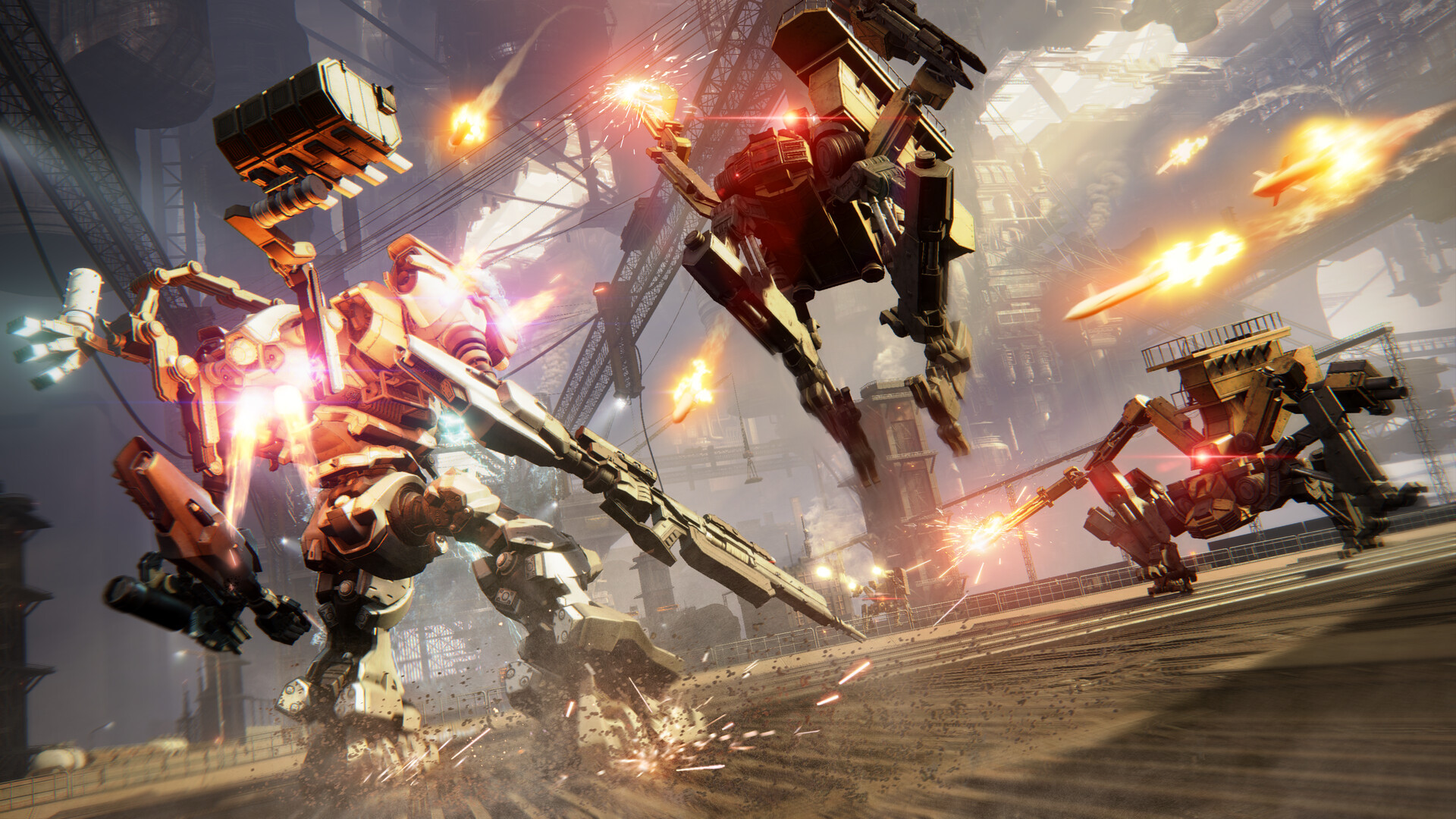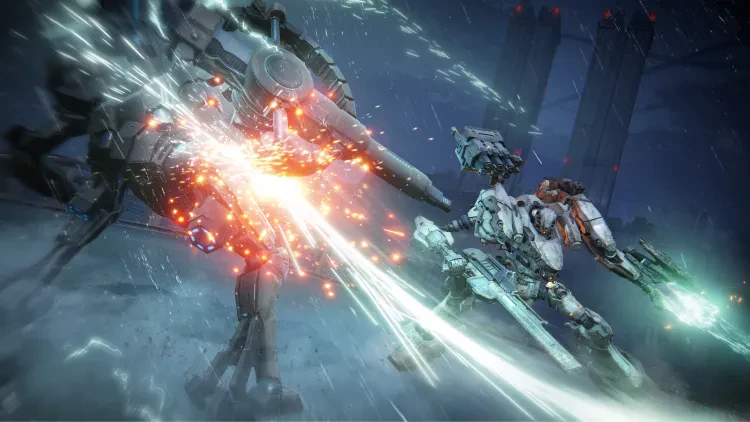Armored Core 6: Fires of Rubicon: A Mech-Driven Return to Form
FromSoftware’s return to the Armored Core series with Fires of Rubicon is a clear testament to their expertise in refining niche, challenging gameplay experiences. This new installment revitalizes the franchise by blending the intense mech combat the series is known for with modern polish and fluid gameplay mechanics. This entry captures the allure of piloting highly customizable mechs in high-stakes, mission-driven warfare, giving players a sense of freedom while upholding FromSoftware’s now-signature difficulty. Below, we’ll dive into the game’s strengths, challenges, and reception to see how this mechanized adventure stacks up.
Visual and Technical Excellence
Graphically, Fires of Rubicon is a testament to modern visual storytelling. The game’s environments are richly detailed, ranging from the decaying industrial landscapes to vast, open wastelands. Each area feels immersive, enhancing the weight and intensity of the mission objectives. Lighting and particle effects play a pivotal role in making every explosion, thruster burst, and weapon discharge feel visually satisfying, making battles not only intense but also a visual spectacle.
The technical aspects also hold up remarkably well. Performance remains steady during large-scale battles, even with numerous enemies and effects on-screen. This is crucial, as fast reflexes are required to stay alive, especially during intense firefights and boss battles. Load times are minimal, which is particularly helpful in a game where players may face defeat frequently and need quick restarts. However, a small number of players have reported occasional frame drops, especially on base consoles, though these instances are few and far between.
Customization: A Playground of Options
Customization has always been at the heart of the Armored Core series, and it’s here that Fires of Rubicon shines. The game provides a staggering array of parts and weapons, allowing players to build their own unique mech suited to their preferred playstyle. Players can meticulously choose from various frames, armaments, boosters, and defenses, creating loadouts that excel in everything from ranged combat to close-quarters brawling. This level of customization allows players to experiment freely, encouraging a trial-and-error approach to finding the optimal setup for different missions and enemy types.
With this variety, the customization can, however, feel overwhelming, especially for newcomers. The learning curve for understanding each part’s stats and synergy with other components may be steep for players unfamiliar with the genre. For dedicated fans of mech-building, though, this depth is likely a major selling point, offering nearly endless combinations to explore.
Gameplay: Precision and Challenge at Its Core
The combat itself is as precise as it is challenging. The game’s mission structure is reminiscent of classic Armored Core titles, featuring short, high-intensity battles that require both tactical thinking and fast reflexes. Missions range from skirmishes against waves of enemies to one-on-one duels with powerful, specialized mechs. The controls are responsive and fluid, making maneuvering in and out of cover, dodging attacks, and targeting enemies feel intuitive. Whether soaring high with jet boosters or engaging in close combat, the sense of piloting a powerful, nimble machine is constantly rewarding.
That said, the difficulty of the game has divided players. Some revel in the challenge, likening it to FromSoftware’s famous Souls-like difficulty, while others feel it borders on frustration. The AI is unforgiving, particularly in later missions and boss fights, requiring players to adapt and optimize both their tactics and loadouts constantly. For those who enjoy methodical, high-stakes gameplay, the challenge is a welcomed return to form. However, casual players or those unaccustomed to FromSoftware’s approach to difficulty may find it daunting.
Storytelling and Narrative Depth
The narrative in Fires of Rubicon is subtly woven through mission objectives, environmental clues, and the occasional character interaction. The story centers on a resource-rich planet embroiled in conflict, with players acting as mercenaries navigating through alliances and rivalries. The game’s dystopian tone is carefully set, and while it may not delve deeply into personal stories or character arcs, it paints an effective picture of a war-torn world driven by corporate interests and survival instincts.
Fans of story-rich games may find the plot somewhat lacking in depth, as it relies more on atmosphere and overarching themes than character-driven drama. The lore is, however, engaging for those who take the time to piece together the world’s history and understand the intricacies of the factions involved. The minimalist storytelling complements the high-octane gameplay, giving players just enough context without distracting from the core action.
Community Reception: Praises and Criticisms
The reception from the gaming community has been generally positive, with longtime fans thrilled at the return of the franchise and newcomers appreciating the refined mechanics and polished visuals. Players have lauded the customization options as one of the game’s best aspects, with many enjoying the freedom to experiment with different builds and strategies. The community has also praised the combat mechanics, noting that they feel responsive, satisfying, and challenging.
However, feedback has not been uniformly positive. A common criticism is the steep difficulty curve, particularly for those new to the series. While FromSoftware is known for its challenging titles, some feel the difficulty here is sometimes inconsistent, with certain bosses or missions feeling disproportionately tough. Another point of contention is the somewhat limited mission variety. Some players feel that the mission objectives can become repetitive, with tasks often boiling down to eliminating a set number of enemies or destroying certain targets. Though this repetition can be mitigated by experimenting with different builds, it remains a notable issue for some.
Sound Design and Audio Cues
Sound design plays an essential role in the game’s immersive experience. The sound effects of mech movement, weaponry, and explosions are meticulously crafted, making every encounter feel intense. The soundtrack, while not overly prominent, does a commendable job of adding tension and atmosphere without overshadowing the gameplay. Audio cues also help players identify threats and differentiate between types of enemy attacks, which is critical for reacting appropriately in fast-paced encounters.
However, some players have noted that the background music can become repetitive during longer play sessions. The game’s emphasis on intense combat sequences might have benefited from a more dynamic soundtrack that shifts in tone and intensity more frequently. This is a minor criticism in an otherwise well-executed audio design but one that some players have noticed.
Final Verdict: A Return to Roots with Modern Refinements
Fires of Rubicon succeeds in reestablishing Armored Core as a franchise capable of captivating audiences with its unique blend of mech customization, challenging combat, and visual artistry. The game captures the spirit of the series while incorporating modern design elements that make it accessible to a new generation of players. Its strengths lie in its meticulously crafted visuals, rewarding customization options, and intense gameplay. While the difficulty may alienate some players, it remains true to FromSoftware’s philosophy, presenting a high-skill experience that feels both rewarding and demanding.
For players who appreciate customization, precise combat, and atmospheric storytelling, this title is likely to deliver hours of satisfying gameplay. The game may not be as accessible to casual players, but for those willing to invest the time and effort, it offers a deep, engaging experience that stands out among mech-based games. With its careful balance of nostalgia and innovation, Fires of Rubicon is a solid entry that manages to respect its legacy while pushing the series forward, making it a noteworthy addition to the modern gaming landscape.
